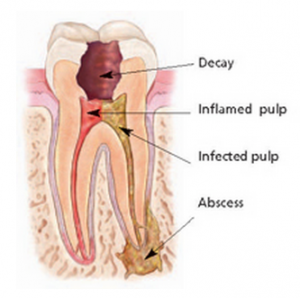 Inside the tooth, under the white hard layer of enamel and the softer layer called the dentin, there is a soft tissue called the pulp. The pulp contains blood vessels, nerves and connective tissue that develops the tooth from within and once fully mature helps maintain it.
Inside the tooth, under the white hard layer of enamel and the softer layer called the dentin, there is a soft tissue called the pulp. The pulp contains blood vessels, nerves and connective tissue that develops the tooth from within and once fully mature helps maintain it.
The pulp can become inflamed or infected from a variety of causes: deep decay, exposed roots, periodontal disease, faulty crowns, or a crack or chip in the tooth, the pulp soft tissue cells may die. This is at times referred to as a “dead tooth”. But it is only the soft tissue inside, that is not viable any more, the hard part of the tooth, the enamel and dentin, can survive without the pulp because the tooth continues to be nourished by the tissues surrounding it. Since the pulp tissue was acting as a barrier to the advancing bacteria if it is dead, bacteria can now progress unchallenged though the canals to the jaw bone, cause pain or lead to an abscess. To stop the progression of the bacteria I need to perform a root canal treatment.